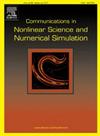考虑异质性成本的社会网络影响节点识别
IF 3.4
2区 数学
Q1 MATHEMATICS, APPLIED
Communications in Nonlinear Science and Numerical Simulation
Pub Date : 2025-07-10
DOI:10.1016/j.cnsns.2025.109110
引用次数: 0
摘要
随着网络社交平台的快速发展,社交网络中的影响力传播分析变得越来越重要。同时考虑影响最大化(IM)和影响阻塞最大化(IBM)的影响节点识别是该领域的关键问题。在现实中,每个用户作为种子参与传播过程所产生的成本可能会有很大差异,这促使人们关注识别具有异构成本的有影响的节点。为了解决这个问题,我们引入了一个考虑成本异质性的二人零和静态攻防博弈模型。攻击者的目标是最大化影响传播,而防御者的目标是最小化影响传播。通过利用该博弈的均衡策略,我们从攻击者、防御者和中立观察者的角度重新定义了影响节点的概念。在无标度网络和现实世界网络上的实验表明,成本异质性和资源约束对双方的均衡策略有显著影响。具体来说,当两个玩家拥有相同的可用资源时,攻击者总是放弃关键节点。随着成本异质性的增加,防御者从优先考虑关键节点转向放弃它们。本研究从攻防博弈的角度推进了对异构成本影响节点的认识,为未来的研究开辟了新的途径。本文章由计算机程序翻译,如有差异,请以英文原文为准。
Identifying influential nodes in social networks considering heterogeneous cost
With the rapid growth of online social platforms, the influence spread analysis in social networks has become increasingly important. Identifying influential nodes while considering both Influence Maximization (IM) and Influence Blocking Maximization (IBM) is a crucial issue in this field. In reality, the costs incurred by each user to participate as a seed in the diffusion process can vary significantly, prompting a focus on identifying influential nodes with heterogeneous cost. To address this, we introduce a two-player zero-sum static attack–defense game model considering cost heterogeneity. The attacker aims to maximize influence propagation while the defender aims to minimize it. By leveraging the equilibrium strategy of this game, we redefine the concept of influential nodes from the perspectives of attackers, defenders, and neutral observers. Experiments on scale-free networks and real-world networks demonstrate the significant impact of cost heterogeneity and resource constraints on the equilibrium strategy for both players. Specifically, when both players have equal available resources, the attacker always drops the critical nodes. As cost heterogeneity increases, the defender shifts from prioritizing critical nodes to abandoning them. This study advances the understanding of influential nodes with heterogeneous costs from an attack–defense game perspective and opens up new avenues for future research.
求助全文
通过发布文献求助,成功后即可免费获取论文全文。
去求助
来源期刊

Communications in Nonlinear Science and Numerical Simulation
MATHEMATICS, APPLIED-MATHEMATICS, INTERDISCIPLINARY APPLICATIONS
CiteScore
6.80
自引率
7.70%
发文量
378
审稿时长
78 days
期刊介绍:
The journal publishes original research findings on experimental observation, mathematical modeling, theoretical analysis and numerical simulation, for more accurate description, better prediction or novel application, of nonlinear phenomena in science and engineering. It offers a venue for researchers to make rapid exchange of ideas and techniques in nonlinear science and complexity.
The submission of manuscripts with cross-disciplinary approaches in nonlinear science and complexity is particularly encouraged.
Topics of interest:
Nonlinear differential or delay equations, Lie group analysis and asymptotic methods, Discontinuous systems, Fractals, Fractional calculus and dynamics, Nonlinear effects in quantum mechanics, Nonlinear stochastic processes, Experimental nonlinear science, Time-series and signal analysis, Computational methods and simulations in nonlinear science and engineering, Control of dynamical systems, Synchronization, Lyapunov analysis, High-dimensional chaos and turbulence, Chaos in Hamiltonian systems, Integrable systems and solitons, Collective behavior in many-body systems, Biological physics and networks, Nonlinear mechanical systems, Complex systems and complexity.
No length limitation for contributions is set, but only concisely written manuscripts are published. Brief papers are published on the basis of Rapid Communications. Discussions of previously published papers are welcome.
 求助内容:
求助内容: 应助结果提醒方式:
应助结果提醒方式:


